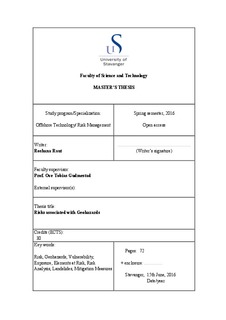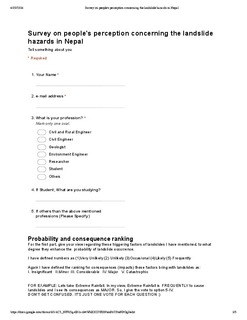| dc.contributor.author | Raut, Roshana | |
| dc.date.accessioned | 2016-10-03T11:00:20Z | |
| dc.date.available | 2016-10-03T11:00:20Z | |
| dc.date.issued | 2016-06-15 | |
| dc.identifier.uri | http://hdl.handle.net/11250/2412528 | |
| dc.description | Master's thesis in Risk management | nb_NO |
| dc.description.abstract | Geohazards refer to the hazards caused by various geological processes and conditions that lead to the damage of existing environment. Geohazards like landslides, earthquakes, tsunamis and snow avalanches are major issues of concern as they pose extreme risks worldwide. Approximately 1.4 billion of the world’s population is vulnerable to these hazards. Thus, there is a need of addressing the risks associated with geohazards for creating a safer future.
The primary objective of this thesis is to broaden the knowledge of geohazard risks by understanding their potential causes, the likelihood of occurrence and their possible consequences. A concept for risk of geohazards is built on the basis of vulnerability, elements at risk and exposure. The risk of geohazards is highly influenced by complexity in human civilization and global climatic changes. Various uncertainties are also associated with geohazards, which needs a thoughtful strategy while making decisions. The qualitative method of risk analysis is adopted, on the basis of which a risk matrix is created.
In this thesis, some significant geohazards in Norway are discussed along with the factors leading to the future risk. As specifics of geohazards, the landslide issue of Nepal is taken. With the identification of triggering factors of landslides and their potential consequences, possible risk mitigation measures are suggested. A probability-consequence diagram is established that gives a clear picture of landslide hazard. Since risk categorization and severity ranking for consequences are subjective issues, an online survey was carried out. The ranking would be a great foundation for prioritizing prevention and mitigation measures in the nearest future and for decision-making matters.
Soil bioengineering techniques are prevalent for several years for the prevention and reduction of landslide hazards in Nepal. Herein, different factors affecting their suitability and efficiency are also discussed. It is concluded that there is a need of broader thinking to adopt new measures of risk management and design for the prevention and mitigation of geohazard risks. | nb_NO |
| dc.language.iso | eng | nb_NO |
| dc.publisher | University of Stavanger, Norway | nb_NO |
| dc.relation.ispartofseries | Masteroppgave/UIS-TN-IØRP/2016; | |
| dc.relation.haspart | An online questionnaire survey form | nb_NO |
| dc.rights | Navngivelse 3.0 Norge | * |
| dc.rights.uri | http://creativecommons.org/licenses/by/3.0/no/ | * |
| dc.subject | offshore teknologi | nb_NO |
| dc.subject | risikostyring | nb_NO |
| dc.subject | risk management | nb_NO |
| dc.subject | geohazards | nb_NO |
| dc.title | Risks associated with Geohazards | nb_NO |
| dc.type | Master thesis | nb_NO |
| dc.subject.nsi | VDP::Technology: 500::Marine technology: 580::Offshore technology: 581 | nb_NO |


